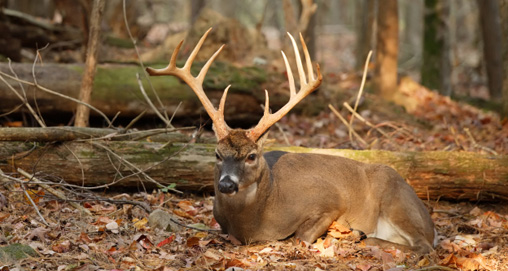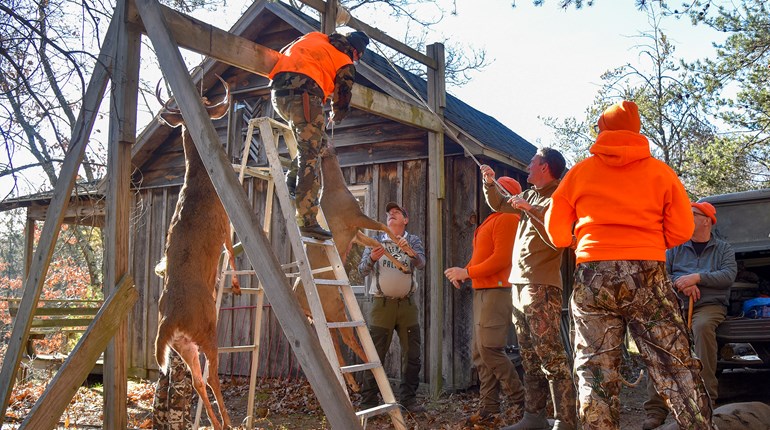
First of all, if shooting a Boone and Crockett Club (B&C) caliber buck were as simple as hunting those counties that consistently produce bucks of absurd proportions, you might think more of us would have one by now. For instance, in the past 15 years I’ve hunted four of North America’s top 10 B&C counties—two of them regularly—but I’ve yet to see such a buck, let alone get a shot at one. And make no mistake, these are counties whose B&C heritage is thriving, so much so that they’ve made the club’s top 10 every year for more than a decade.
I even live in one of them. My home county, Waupaca, Wisc., put 17 bucks into B&C’s book from 2000 through 2009, ranking it 10th behind longtime standouts like Wisconsin’s Buffalo County, Texas’ Maverick County and Illinois’ Pike County. Nine Waupaca County Booners fell between 2005 and 2009, tying it for seventh place among the top B&C counties.
But free-ranging B&C-caliber bucks will never be numerous nor easy to find. Even whitetail breeders who utilize high fences can’t crank out clean-antlered B&C bucks, even though they control the bucks’ breeding, weaning and feeding.
The fact remains that few whitetail bucks have the potential and the opportunity to grow antlers meeting the B&C’s minimum record-book scores—160 inches for each triennial “Awards” period and 170 inches for “All-Time” records for typical antlers; and 185 for Awards and 195 All-Time records for non-typical antlers.
Consider the B&C odds in my home county. Waupaca’s nine B&C qualifiers from 2005-09 came from a combined buck harvest of 23,350 bucks during the past five seasons, or one Booner per 2,595 antlered bucks. If boiling maple sap rendered such results, who would bother making syrup?
But deer hunters are optimists when heading for the treestand or ground blind, especially after studying B&C records during the offseason.
And if you have bucks making the B&C book, then you have a lot of bucks being killed that are mature and big, which is really the whole point. Mature bucks in a herd means the herd is well balanced and has good nutrition. Big bucks are not just the stuff of dreams, they also show that a herd is healthy and that hunters are doing a good service for the habitat that helps everything from songbirds to bears.
Here are some reasons why deer hunters should be more optimistic than ever:
■ Whitetails make up 34 percent (1,708) of the 4,987 trophies qualifying for the B&C’s current triennial Big Game Awards; its 27th scoring period.
■ Of the nearly 37,800 entries in B&C’s all-time record books, almost 7,100 (18.75 percent) are typical-antlered whitetails.
■ From 2000 to 2009, hunters registered 4,423 whitetail bucks with B&C, the most recorded by the club in any decade.
■ Those 4,423 trophy bucks from 2000-09 make up nearly 40 percent of all whitetails in the club’s book.
■ That 2000-2009 cohort is a 31 percent increase from the 3,387 B&C whitetails registered in the 1990s.
■ Further, the 1990-99 totals (3,387) were only 17 bucks fewer than all the B&C whitetails recorded prior to 1990 (3,404).
And the increase in big bucks isn’t confined to the Midwest and Texas. Incredibly, B&C entries from the Northeast’s 10 states jumped to 183 in the 2000s, a 37 percent increase from 133 in the 1990s. This includes Rhode Island, which put three bucks into the book after recording none in previous history. And B&C entries from the Southeast’s nine states reached 188 in the 2000s, a 9 percent increase from 173 in the 1990s. The most noticeable changes were Mississippi, which jumped 71 percent to 48 entries. Also, the number shot in Tennessee leapt 150 percent to 25 entries.
Of the top 10 whitetail states in 2000-09, eight increased their entries from 1990-1999, and Indiana made the short list for the first time. Only the province of Saskatchewan saw a decline, though merely by eight bucks. The top states with increases were Illinois, Wisconsin, Iowa, Kentucky, Ohio, Missouri, Kansas and Minnesota.
Minnesota’s B&C staying power is without peer; it posted increases for six straight decades and never once fell from the top 10. Its 193 entries for 2000-09 placed it 10th on the list. It was No. 9 in the 1990s with 168, No. 1 in the 1980s with 142, No. 1 in the 1970s with 138, No. 1 in the 1960s with 94 and No. 1 in the 1950s with 53.
Wisconsin’s Buffalo County remained the No. 1 county for the third straight decade by placing 44 bucks into B&C in 2000-09. It was also No. 1 in the 1990s with 25 and No. 1 in the 1980s with 14.
Illinois has no equal for B&C non-typicals; it recorded 251 of the 1,637 entries (15 percent) in 2000-09. It was also No. 1 during the 1990s, with 161 of the 1,145 entries (14 percent).
More counties are vying for top honors. Of the top 10 B&C counties in 2000-2009, six were not on the 1990-99 list. Wisconsin’s Buffalo, Iowa’s Allamakee and Illinois’ Pike and Adams counties held their spots. Wisconsin added Trempealeau and Waupaca to the list. Other new counties were Maverick, Texas; Dubuque, Iowa; and Schuyler and Jo Daviess, Ill.
A “Competitive” Top 10
When looking beyond individual counties to state/provincial totals from the 2000s, the larger sample size stabilizes the B&C field. The only change from the 1990s’ top 10 was Indiana bumping out Alberta. Illinois, Wisconsin and Iowa still hold the top three spots; Kentucky, Ohio, Missouri, Kansas, Saskatchewan and Indiana vie for the middle; and Minnesota solidified the 10th spot ahead of Texas and Alberta.
But that stability is anything but static. Keith Balfourd, marketing director of the B&C Club, said, “The states atop the heap just kind of subtly change positions over time, but there’s nothing subtle about their numbers.”
For instance, eight states showed skin-stretching growth for B&C entries in 2000-2009, led by Indiana’s 127 percent increase from 106 to 241, and Ohio’s 101 percent increase from 154 to 309. The other states’ totals grew as follows:
■ Illinois, up 31 percent, 412 to 539
■ Wisconsin, up 59 percent, 292 to 464
■ Kentucky, up 62.5 percent, 192 to 312
■ Missouri, up 53 percent, 186 to 285
■ Kansas, up 48 percent, 174 to 257
■ Minnesota, up 15 percent, 168 to 193
Only Saskatchewan had fewer Booners (256) the past 10 years than in the 1990s (264). Iowa increased from 347 to 349.
Does Size Matter?
The upper Midwest not only dominates in sheer numbers of B&C bucks, it also generates most of the biggest bucks; for instance, 37 of the top 50 typicals of the 2000s came from those top 10 states and provinces; likewise, 42 of the top non-typicals came from there.
One of the great things about B&C bucks, however, is their sheer unpredictability. Consider Maryland and Wisconsin: Maryland has 80 bucks in the B&C’s all-time records, about 7 percent of Wisconsin’s 1,075. During the past decade alone, Wisconsin’s top three counties—Buffalo, Trempealeau and Waupaca—combined to put 80 bucks into the book. Meanwhile, Maryland had been gaining steam; it put 31 bucks into the book during the 2000s—not quite 7 percent of Wisconsin’s 464, but still a serious up-tick.
Likewise, Manitoba fell from Canada’s No. 3 province of the 1990s to No. 5 in the 2000s when its entries dropped from 36 to 20. Ontario took the No. 3 ranking during the past decade with 44 entries, up from No. 6 in the 1990s when it had 16. For size, though, Manitoba placed three typicals and two non-typicals into the top 50.
You get the point. Although the whitetail’s range doesn’t include many of the United States’ 3,141 counties, it almost seems B&C bucks are popping up everywhere. That’s especially true when landowners, hunting clubs or local cooperatives pool their properties, pass up younger bucks, shoot more antlerless deer and carry out habitat-improvement projects to ensure deer have high-quality nutrition and cover.
Dr. Mickey Hellickson, a wildlife biologist, smiled recently when seeing that Union County, Iowa, placed nine bucks in the B&C book during the 2000s. That put Union County in a tie with six other counties for 19th place in North America’s top whitetail counties.
Okay, why was Hellickson smiling? Not only is he an Iowa native, he’s part of a hunting cooperative in Union County that currently covers 4,000 acres but has been as large as 9,000 acres since its 1996 launch. This single cooperative produced six of the county’s nine B&C entries from 2000-09.
“The biggest thing we do is selectively harvest mature bucks,” Hellickson said. “We also do year-round habitat work in the woods, maintain food plots and bring in friends and family members to help with the doe harvest every year. The bottom line is you have to let bucks reach older ages. Whether it’s rugged habitat, selective harvest or restricted access, the only way a buck can make B&C is to avoid a bullet or an arrow for at least four to five years.”
Hellickson said though it takes longer for South Texas bucks to reach such proportions, several make it each year for three reasons. “Maverick, La Salle, Webb, Dimmit and Kleberg all produce B&C bucks because they have large, private ranches with really light hunting pressure,” he said. “About 30-plus percent of the bucks on well-managed ranches reach 51/2 years and older.”
Dr. Joel Helmer, a geographer and whitetail addict at Nebraska’s Concordia University, echoes those thoughts. He created a wall-poster map for the Quality Deer Management Association that shows the distribution of bucks in the Boone and Crockett Club and Pope and Young Club record books.
“Because you’re dealing with such rarities to begin with, it doesn’t take much to influence the record books,” Helmer said. “Most counties cover a large area, but sites that produce record-book bucks are usually relatively small parts of a county with specific habitat and management differences that set them apart. In some cases, it literally can be one family or one group of hunters putting that county on the map.”
With more hunters following herd- and land-management programs that benefit deer, and with the flexible and adaptable whitetail prospering across diverse landscapes, we should expect to keep adding pages to the B&C’s record book in the years ahead.
“More bucks are making the book from New York, Pennsylvania, Maryland and New England than ever before,” Balfourd said.
Hellickson agrees. “Deer hunting is the backbone of hunting in the United States, and it’s now giving people more reasons to connect with the land by managing it for deer.”





































